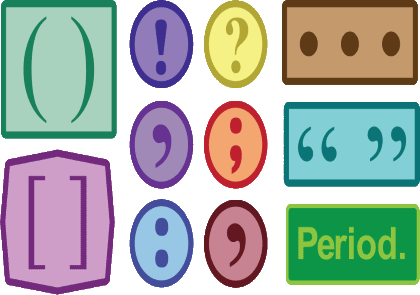Punctuation is used to create sense, clarity and stress in sentences. You use punctuation marks to structure and organise your writing. There are 14 punctuation marks that are commonly used in English grammar. They are the period, question mark, exclamation point, comma, semicolon, colon, dash, hyphen, parentheses, brackets, braces, apostrophe, quotation marks, and ellipsis. Following their correct usage will make your writing easier to read and more appealing.
You can quickly see why punctuation is important if you try and read this text which has no punctuation at all:
perhaps you dont always need to use commas periods colons etc to make sentences clear when i am in a hurry tired cold lazy or angry i sometimes leave out punctuation marks grammar is stupid i can write without it and dont need it my uncle Harry once said he was not very clever and i never understood a word he wrote to me i think ill learn some punctuation not too much enough to write to Uncle Harry he needs some help
Now let's see if punctuating it makes a difference!
Perhaps you don't always need to use commas, periods, colons etc. to make sentences clear. When I am in a hurry, tired, cold, lazy, or angry I sometimes leave out punctuation marks. "Grammar is stupid! I can write without it and don't need it," my uncle Harry once said. He was not very clever, and I never understood a word he wrote to me. I think I'll learn some punctuation - not too much, enough to write to Uncle Harry. He needs some help!
Lessons
-
The apostrophe ( ’ ) is used to show that something belongs to someone. It is usually added to the end of a word and followed by an -s
-
There are some general rules which you can apply when using the comma. However, you will find that in English there are many other ways to use the comma to add to the meaning of a sentence or to emphasise an item, point, or meaning.
-
Quotation marks (" ") are a pair of punctuation marks used primarily to mark the beginning and end of a passage attributed to another and repeated word for word. They are also used to indicate meanings and to indicate the unusual or dubious status of a word.
-
Use capital letters in the titles of books and other publications, films, organizations, special days, etc. In such cases, you need a capital letter for all the main words but not for the connecting words such as a, an, the, or, and, etc...
-
-
The question mark [ ? ] (also known as interrogation point, query, or eroteme in journalism) is a punctuation mark that indicates an interrogative clause or phrase in many languages. The question mark is not used for indirect questions.
-
The exclamation mark (British English and American English)) or exclamation point (American English) is a punctuation mark usually used after an interjection or exclamation to indicate strong feelings or high volume (shouting)...
-
A colon introduces an element or series of elements that illustrates or amplifies the information that preceded the colon. While a semicolon normally joins two independent clauses to signal a close connection between them...
-
Use a semicolon between closely related independent clauses which are not joined by a coordinating conjunction. This rule means that semicolons are used between two complete sentences which are not already linked by words like and, but, or, nor, for, so, yet.
-
Parentheses (always used in pairs) allow a writer to provide additional information. The parenthetical material might be a single word, a fragment, or multiple complete sentences.
-
Hyphens are used at the ends of lines where a word has been split, to warn the reader that the word continues on the next line. If the word you need to split is clearly made up of two or more smaller words or elements
-
A dash is a little horizontal line that floats in the middle of a line of text (not at the bottom: that’s an underscore). It’s longer than a hyphen and is commonly used to indicate a range or a pause.
-
